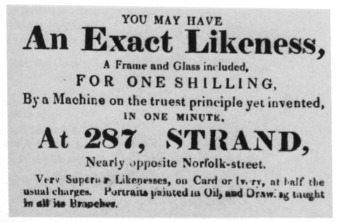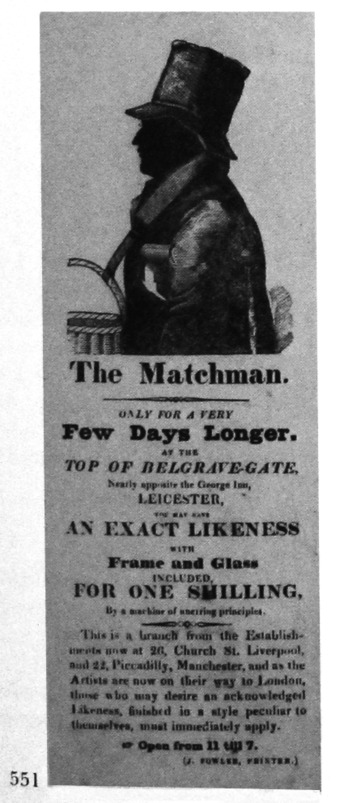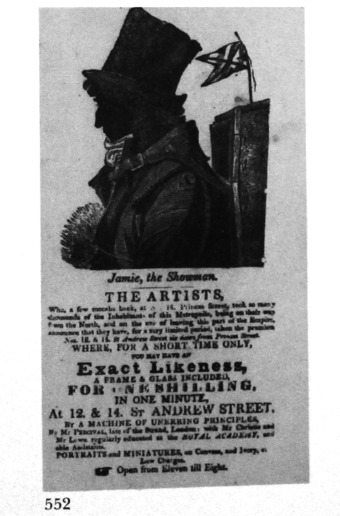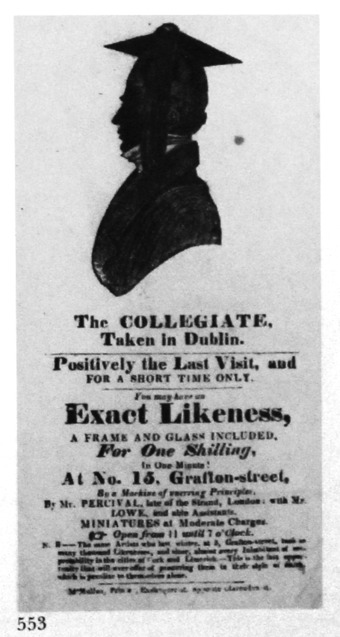Percival (McKechnie Section 1)
See also Section Six
Briefly recorded by Jackson (Dictionary). The existence of this artist, and of the gallery which he managed, is known from six handbills, or advertisements, all of which must have been issued from the same source (this is clear from a comparison of the texts) though not all of them bear Percival's name. Five are in the Bodleian Library (John Johnson collection); one of them (the last) is illustrated by Jackson in her Dictionary. Four of the five handbills in the Bodleian are headed by a reproduction of a silhouette (different in each case) previously taken by the gallery. As none of the handbills are dated it is difficult to deduce from them accurate information about when the gallery was working in the towns mentioned. and the task is complicated by the eccentric or unusual dress (itself difficult to date) of the subjects of the illustrated silhouettes. It is also difficult to compile an itinerary: one handbill indicates that several branches of the gallery were open simultaneously in different towns.
Since two of the handbills refer to Percival as ‘late of the Strand, London’, we can infer that the first of the handbills illustrated here (which gives the 550 address 287 Strand) was the earliest extant example to be issued, and probably dates from the early 1820s. It does not mention any artist by name, and it appears that portrait miniatures were offered as well as silhouettes.
Probably the next handbill to be issued was one (illustrated) headed by a reproduction of a silhouette (taken in Leicester, possibly during the mid-1820s) of a character called ‘The Matchman’, used in Leicester, possibly during the mid-1820s. It is clear from this handbill that the gallery had become successful: it had two centres (at 26 Church Street, Liverpool, and 29 Picadilly, Manchester); Leicester was a branch; and at least two artists must have been employed.
By c. 1827-28 the gallery had moved to Scotland, as shown by a handbill (illustrated) which can be dated to these years. From this we gather that the gallery was now back in Edinburgh (at 12 and 14 St Andrew Street), after visiting the north of Scotland, having earlier stopped in the city at 14 Princes Street. The profile of ‘Jamie the Showman’, illustrated on this handbill, may have been taken during the first visit to Edinburgh, being used now as a reminder to the public. For the first time, artists are mentioned by name: Percival, Lowe, and Christie. Lowe may have been the T. Lowe (q.v.) who worked independently under his own name. Christie may well have been Alexander Christie, ARSA (1807-60), who was born in Edinburgh and at this time would have been practising as a lawyer. Though he was always enthusiastic to become an artist, he did not actually begin his artistic training until 1833; nevertheless he may have joined the gallery while it was in Scotland in order to gain experience. (In the Wadsworth Athenaeum, Hartford, Connecticut, there is a portrait miniature by Christie dated 1830.) Alternatively, the artist may have been Thomas Christie, of whose work as a miniature painter one example (1830) is recorded by Long. As well as the three named artists, assistants were employed. Not only are silhouettes and miniatures offered, but also portraits on ‘canvass’.
The phrase on this handbill, ‘on the eve of leaving this part of the empire’, must refer to the gallery's move to Ireland which is indicated by the last two of the handbills in the Bodleian and the handbill illustrated by Jackson. One of the handbills in the Bodleian is headed by a reproduction of a silhouette of ‘Mick the Fool’, captioned below, ‘Taken in Limerick’. ‘Mick’ is shown wearing a military-style frock-coat, with full sleeves, of the type widely worn during the late 1820s. The other handbill from the Bodleian (illustrated) is also headed by an illustrated silhouette, in this case ‘The Collegiate’, below which is the line ‘Taken in Dublin’. Otherwise, both handbills are identically worded, both were printed by the same printer (McMullen, Exchequer Street, Dublin) and both were published, apparently, in the late 1820s. Both refer to two artists (Percival and Lowe) as well as assistants; both appear to have been issued from 15 Grafton Street, Dublin, during the same season; both refer to a previous winter season at 5 (not 15) Grafton Street, followed by a sojourn in Cork and Limerick. The third handbill (illustrated by Jackson) is a slightly altered version of the handbill illustrating ‘The Collegiate’, used at 7 Grafton Street during the next season. It refers to ‘last season’ in Dublin, Cork and Limerick. We can infer that the gallery may have been in Ireland for at least two years.
The text (below the portrait and caption) is as follows:
FOR A SHORT TIME ONLY
You may have an
Exact Likeness
A Frame and Glass included
For One Shilling
In One Minute
At No. 7, Grafton Street
By a Machine of unerring principles
By Messrs. PERCIVAL & LOWE, with
Mr. Megit, and able Assistants
Being the same Artists
who took so many Thousand Likenesses
last Season in DUBLIN, CORK, AND LIMERICK
Miniatures at Moderate Charges
Open from 11 'till 7 o'clock.
MCMULLEN, Printer, Exchequer Street
It is interesting that, if my estimated dates are correct, Cork and Limerick were well ‘covered’ by Percival's gallery several years before Edouart visited them. Another artist, Megit (q.v.), is mentioned on this handbill for the first time. The same man as the ‘Mr Might’ recorded by Jackson (who also has an entry on Megit) in her Dictionary, he may have been with the gallery for some time, but only now (when Lowe had been promoted to a partnership) was it thought appropriate to mention Megit by name. These three handbills, issued in Ireland, provide the last documentary evidence of the gallery's existence. If the Lowe who eventually became Percival's partner was indeed T. Lowe, then by 1 March 1831 (the date of the earliest known silhouette taken independently by T. Lowe) either Percival was managing the gallery alone or it had closed down.
In considering the type of work done by Percival's gallery we have to bear in mind that no silhouettes have survived: only the illustrations of them reproduced on the handbills. (A silhouette of a Mrs Fonnah, referred to under the Artists' Saloon, may have been produced by Percival's gallery.)
We are of course concerned with the work of several artists. Since the short handbill showing the address at 287 Strand presumably refers only to the work of Percival himself, and also offers portraits in oil, Percival was presumably an accomplished artist. The handbills, however, reiterate the price of only one shilling, presumably charged for a plain black profile, cut by a machine, possibly that of Hawkins (see William Farthing, Section Three) or C. Stanley (q.v.).
Since Lowe seems to have worked with Percival's gallery for some time, he must have been responsible for much of the gallery's output. In his independent work, he painted in gum arabic against a cut dark-grey background; his profiles are not as well executed or well finished as those of Gillespie (see Section Two) who excelled at painting in gum arabic against grey and was working in England shortly before Percival's Gallery seems to have toured the country.
It is possible that the gallery offered bronzed work, since so many artists were employed, but Percival seems only to have advertised his low-priced cut profiles. There seems to be no evidence that full-length work was produced.
The profiles shown on the handbills are of course engraved, and since the engraver may have employed some artistic licence it is impossible to attribute the originals to any one artist. We cannot know what frames were used; possibly they were of papier mache, but at such a low price it is more likely that cheaper rectangular wooden frames were offered.
It seems likely that either a stencil or a printed label was used, although at the time of writing none has been seen.
551 550 551 552 553
Ills. 550-553

Handbill or advertisement issued by Percival’s gallery from 287 Strand, London, in the early 1820s.
Bodleian Library, John Johnson collection

‘The Marchman’
Handbill or advertisement issued by Percival’s gallery, probably in the mid-1920s.
Bodleian Library, John Johnson collection

‘Jamie the Showman’
Handbill or advertisement issued by Percival’s gallery, c. 1827-28.
Bodleian Library, John Johnson collection

‘The Collegiate’
Handbill issued by Percival’s gallery, c. 1828-29.
Bodleian Library, John Johnson collection
